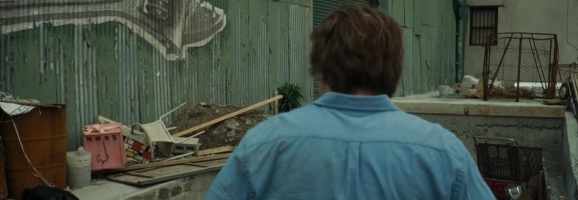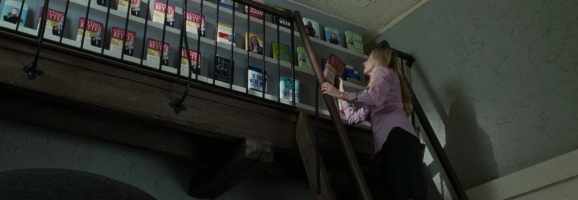“Synecdoche, New York”: Kaufman on Modern Art

When I think of modernism, I think of Piet Mondrian, Dutch painter and De Stijl innovator. I also think of Baudelaire, but that’s for a different time.
Mondrian deemed his paintings, non-representational, geometric, and on a decisive modern grid, “neoplastic,” a new approach to the plastic arts. The paintings, at least the ones he is known for, always composed of black, white, and primary colors, in rigid, solid forms, have names like “Composition with Yellow,” “Composition with Red, Yellow, and Blue,” and “Composition No. III.”
Mondrian, who lived between 1872 and 1944, perfected this neoplasticism throughout the 1910s and 1920s, and he believed that his perfect vertical and horizontal forms “come as close as possible to the truth,” as he wrote in a letter to H.P. Bremmer in 1914, and that his art was “as strong as it is true.” Like Malevich and the Suprematist painters, Mondrian sought to paint pure artistic feeling rather than figurative depictions, and both parties saw their endeavors as a means to a lofty utopian end.
The work of Mondrian, simple, bold, is highly modern because it rejects painting canon, and because it is charged with radical, social and political ideas. Mondrian’s paintings are about painting, but also attempt to reach universal truths through a universal language. These modern painters believed that art could make sense of a world at war, and be man’s salvation. Mondrian’s perfect forms, rigid and solid, are pillars to uphold man’s civilization and restore his purity.
Which is why I was intrigued to see a Mondrian-looking design amidst some garbage in Charlie Kaufman’s “postmodern” masterpiece, Synecdoche, New York (2008). Here is a definitive postmodern film, pulling out every postmodern trick in the book, with a Mondrian painting, such an iconic symbol of modernism, casually sitting in a garbage heap. It’s such a small, delicate detail, and after an hour or so of scouring internet reviews, found no mention of it in the plethora of its glowing reviews (notoriously, Roger Ebert named in “film of the decade”). Maybe it wasn’t even a detail, maybe it was just a coincidence, or merely some meaningless addition to one of the film’s less used sets.
But it has to mean something.
The film, which plays with notions of Jungian psychology, innumerable puns, the ideas of postmodern philosopher Jean Baudrillard, and centers around a meta-referential play-within-a-play which seems to refer to Shakespeare, is all very Charlie Kaufman, who also wrote Being John Malkovich, Adaptation., and Eternal Sunshine of the Spotless Mind, and each step of its madness feels very deliberate. There are numerous references to other works of art in the film, notably Kafka’s The Trial and Proust’s Swann’s Way, and the entire film concerns itself with art, art’s meaning, and the life of the artist.

Caden Cotard (Phillip Seymour Hoffman) is a theater director whose bodily functions and social interactions are deteriorating. After his wife, a painter of miniature paintings, leaves for Berlin seemingly for good, with their daughter, Cotard receives a MacArthur Fellowship, which grants him the financial means to pursue his artistic interests. In the letter’s own words, “create something unflinchingly true, profoundly beautiful, and with unremitting value to your community and the world at large.” Later, Cotard explains to his therapist, that he wants to create something “big and true and tough – finally put my real self into something.”
Cotard’s words absolutely mirror Mondrian’s words, the need to create something large and universal, and something that digs into the purest truth of the human being.
Cotard’s own name refers to the Cotard delusion, a rare mental disorder where one believes he is dead or putrefying, or are losing blood and organs. Throughout the film, he has trouble urinating and suffers from other bathroom related issues, he gets cut open multiple times, and he ages indefinitely without regard to the film’s actual time span.
Time in the film is shaky at best, with characters aging quickly, and time passing lawlessly. Cotard ages, and he mentions casting young actors as old characters in theater as a style choice. This is one of the film’s largest “postmodern” themes, the degradation of time, interaction, and identity, and as Cotard’s project commences, his life becomes further contorted. Actors from the project end up playing Cotard himself as he directs, often better than he can, and the women that filter into his life are ever shifting throughout reality and the play.
Cotard’s body decays as his theater project grows to an impossible immensity. In his search for universal truths, he grows old, tired, and eventually, dies, without his project ever finishing (or really starting). He stages an infinite number of small scenes inside an impossibly large warehouse, scraping at the human condition, but the play has no audience. Eventually, the play grows so large as to encompass all of New York City, unmanageable and meaninglessly huge.

There seems to be a distinct parallel between Cotard’s art and his wife’s art. Adele’s (Catherine Keener) paintings are so tiny that they must be viewed with magnifying glasses. The tiny paintings depict people from her life, intimately, and are wildly popular internationally. There is a real human quality to them, aided by the intimacy that the gallery visitors experience when seeing them so closely. Even the gallery has a strange mood lighting, as if the paintings are to romance their viewers, up close and personal.
Whereas Cotard’s work, his vision, is far too expansive, never complete, too difficult to control. His artistry, unlike his wife’s, is nonexistent as soon as the project begins. He cannot capture any universal truths, no matter how much of the universe he has stuffed into his play project. Cotard “puts himself” into the project until there is nothing left of him, and the actors must take over “being Cotard.” In his grand delusion, Cotard is never satisfied.
And unfortunately for Cotard, each of his delusions commingle, his social delusions, his bodily ones, and the ones for his art. While a good artist is never satisfied, Cotard’s lofty aims seem delusional from their onset. Strikingly, the towering sets he builds in his warehouse mirror the towering set in his therapist’s office, where she peddles easy answers and absurdly unhelpful self-help books. Both artists, the director and the author, are delusional, their art false, just on different scales and with possibly different motives (the therapist comes off as malicious as she does absurd).

It would not be fair to call Cotard pretentious, to say that he was done in by his own pretentiousness. It is rather his naivety, his belief that only art can save his soul, that ruins him, as it is his art that eventually bleeds him dry.
When Kaufman throws Mondrian in the trash, he seems to be making the claim that seeking a universal truth is naive and even dangerous, and that art cannot save mankind. This is a very postmodern notion, or at least an anti-modern one. As the 20th century dragged on, the utopianism of art was replaced with cynicism, modern thought shifting to postmodern thought. The romantic idea that universal truths could exist at all, and that art was the key toward them, seemed to fade away in the post-World War II decades and beyond. The abstract expressionism of the mid-century, the idea that the artist possesses a unique hand, a special touch, was replaced by a more cynical, replicative Pop Art and post-painterly abstract art.
In terms of the artist, it is easy to juxtapose someone like Jackson Pollock to Cotard. Pollock, an “action painter,” a kind of hero for bohemians and cult classic of his day, probably the last great modernist painter, with his action-oriented abstract paintings, youthful and full of energy, is the exact opposite of Cotard, a man of decay, inaction, who attempts to find value and truth but finds only crooked social interactions and sickness. Like Cotard’s wife, there is something human and warm, or at least primal in Pollock, whereas Cotard’s art is an empty one.
The question for audiences then is, is Kaufman being ironic when he throws Mondrian in the gutter? Is Kaufman, as a “postmodernist” probably would, arguing that universal truths are non-existent, that art is ultimately unsatisfying? That claim is somewhat immoral, though, and I think there is more to Kaufman’s thesis. The art of Cotard’s wife is intimately human, and may be the more “true” of the two arts in the film. Kaufman may be saying that art is only true when it is human, and when it is intimate with its audience.
But at the same time, Adele’s painting career is cast in an absurdly popular light, as if she too is a cynical joke. At one point in the film, Cotard reads an article about his wife in a magazine, where her popularity is exaggerated to the point of absurdity. This may be to contrast her and Cotard as artists, but it also seems like a joke against Adele.
There are no easy answers in Synecdoche, New York, obviously, but Kaufman’s thesis may be buried under too many layers for its own good. There is a satisfaction in using Baudrillard to analyze the film, a joy in picking out the psychology references. The film is intensely sad, but also one of the funniest movies ever made. It is gross, sometimes scatological, and takes the idea of the play-within-a-play to a new height.
But what does the film say about art and the artist? Roger Ebert, in his almost ethereal review of the film, claims that Synecdoche, New York is not about art and artists, but about a human condition, about behavior, control, and the roles people play and expect others to play. There’s no fault in Ebert’s view, and obviously, as they say, “it’s open for interpretation,” but the film is decisively “postmodern” and deliberately features a scene with a Mondrian painting in a garbage pile for a reason.
An acceptance of the non-existence of universal truths and values, is as brave as it is dreary, and the same can be said of the film. A film centered around the failure of art is bold, unsatisfying, possibly immoral, and must be as equally as unsatisfying to the artist who made it. There’s a deep depression hanging over the film’s narrative, one that lingers and does not dissipate.
Though, at the end of the film, as Cotard fades into death, one of his actresses sits with him, allowing him to rest his head on her shoulder. This is the first scene in a long time where Cotard has a stable interaction with another human being, even if it is just one of his actors, and the two share a tender, warm moment before he draws his last breath. With his last words, he explains that he has a new idea for the play, a final declaration that the artist is never satisfied, can never or should never find the true vision they seek. The artist cannot save society, nor can the artist save himself, but at least relationships, human interaction, exist, to lessen the pain and, hopefully, provide meaning where there is none.
What do you think? Leave a comment.











Quite sad movie. This movie hit me on such a personal level. It was magnificently made, but it would take a lot for me to watch it again on my own time. A kick in the gut really does put it perfectly.
For some reason, bleak as the themes may be, I never find Charlie Kaufman’s films to be depressing. They are handled with such a crazy sense of humour & comic relief (like the sad scene where he has to use artificial tears lol) that I can’t stay depressed for long.
Even the scene where he finds his daughter is so damn funny (the way they’re using that weird English-German translation gizmo) I find myself laughing despite the heaviness of the situation. Even at the end of the movie I felt refreshed, as if the whole experience was a catharsis. Like getting an enema from a guy in a clown suit, you gotta crack a smile. So I would assume…
I think the “everyone has tattoos” bit is one of the funniest things I’ve ever seen. But there are scenes, particularly in the second half of the film, that are just so densely tragic (like the roof jumping scene).
This film does take a lot out of you emotionally if you give yourself up to it. But I personally do not find it sad. It might be the bleakest film I’ve seen since Todd Haynes’ Safe, but I don’t find it sad, per se.
I just rewatched it for the first time since I saw it in theaters back in 2008. I think I was overwhelmed at the time by how uncomfortable I felt. You could almost cut the audiences’ dislike and confusion over the film with a knife. It hung over the crowd and it made me embarrassed for Kaufman and for everyone else in the theater.
No film has ever made me feel that way before, feeling so very self-conscious around others. I just rewatched it alone for a few weeks ago and I was able to digest the twisting metaphors, intrinsic sadness, and unconventional narrative form better without feeling required to talk about it afterwards.
And yet here I find myself talking about it. It’s a film that does demand questioning and for that alone, I love this movie. It doesn’t make me feel good, but I really like this movie.
I love seeing films in theaters just to get a gist of what everyone’s reactions are. One of my favorite moments in film was when I saw The Master and at the end of the film, people were rolling in the aisles with laughter at how bad they thought it was. While I’ve come around to liking the film, that remains a great moment.
To me this is the perfect movie! I guess it has become my favorite.
I watched about twenty minutes of it and got a headache and felt nauseous. It genuinely felt like the film’s subject matter and direction was the cause of my feeling ill. Still gathering up the courage to watch the rest.
It’s certainly exhausting *phew*
It’s a nauseating film, but I think this is largely unrelated to its subject. The film was visually ugly – shot in a kind of fuzzy, scuzzy style that would put you off your food whatever the subject matter. The sound crew seemed to have a microphone right down Phillip Seymour Hoffman’s throat. The actors appeared sedated. The same story lousy story and confused script would not have nearly so nasty an effect on one’s stomach if it were crisply shot and competently directed.
I like this opinion, but I’m not so sure. Something like Magnolia is brutally shining, but it’s still vertigo inducing. Synecdoche is nasty, bloody, greasy, and dark, but its script is harsh, too. It never lets the audience breathe, never gives them something stable to hang on to.
Really enjoyed this analysis, good work!
I can’t get over how profound the symbolism in this movie is. Just superb. Not a second is wasted, not a single word out of place. From the very beginning to the end…
I tend to side with Ebert’s interpretation (generally), although I never noticed the Mondrian before, and your analysis of this element is quite seductive.
I think that the film can definitely be read as a statement that there are no universal truths for art to uncover. However, I think it’s more difficult to claim that the film is about the failure of all art and not just Caden’s, for not all art is seeking the universal. Adele’s art is very successful, for example. To me, the film seems to be saying that successful art is limited and has clear borders (like the miniature paintings). The artist knows how the parts fit together and understands his/her subject and, thus, can frame it in a way that helps us understand it, too. But Caden does not understand how the parts fit together (in his play, but also in his life and even within his own body). Also, he sets no limits to his art and tries capturing the totality of existence through it. It is no surprise that he fails, and the tragedy is that his obsessive quest to find truth and meaning in his art leads to his failure to find it in life.
The Mondrian in the trash heap is a great detail that I had previously missed on multiple viewings. Thanks for writing about it!
Definitely. Caden’s hunger for the “totality of existence” is almost Wagnerian in its attempt to do something so inhumanely large. The film’s treatment of Adele’s art always seems to be shifting and is a bit ambiguous, but I think you’re right about the miniature paintings.
And I’m not sure why no one ever (to my knowledge) mentioned the Mondrian image in the trash…the first time I watched the film, I was sort of half asleep, going in and out of consciousness, and I saw that scene and then watched about five minutes more and was like “wait a minute” and went back. It was sort of an a ha! moment for me, but I still wonder what Kaufman’s intention actually was…
I really enjoyed this article and it’s thorough criticism of the directors choice to obscure the thesis behind multiple metaphors and twisting and sardonic visual cues.
I don’t think that the assertion that Adele is successful can be taken at face value. It could very much be the part of every human’s life where they look at someone thinking that they have it figured out.
Major problem here : Cotard wants to have all in his work, but does not consider what a particular thing might mean.